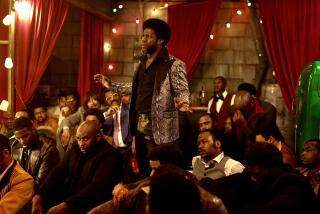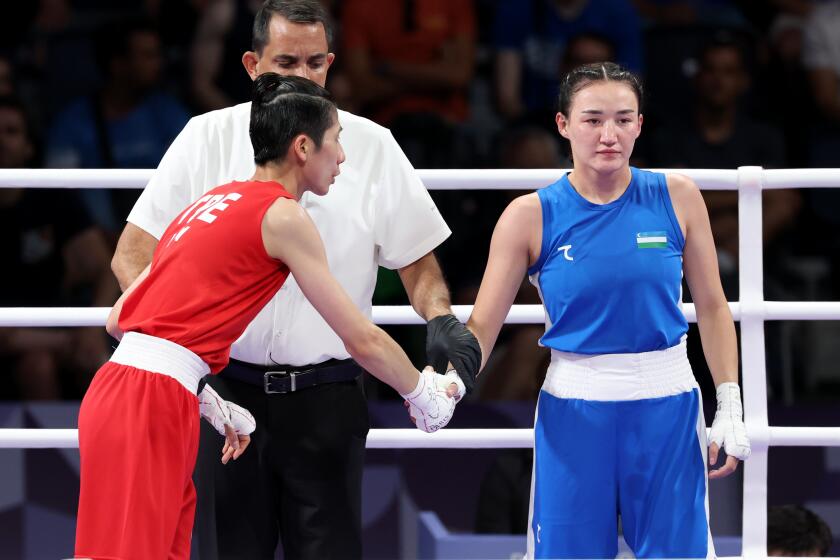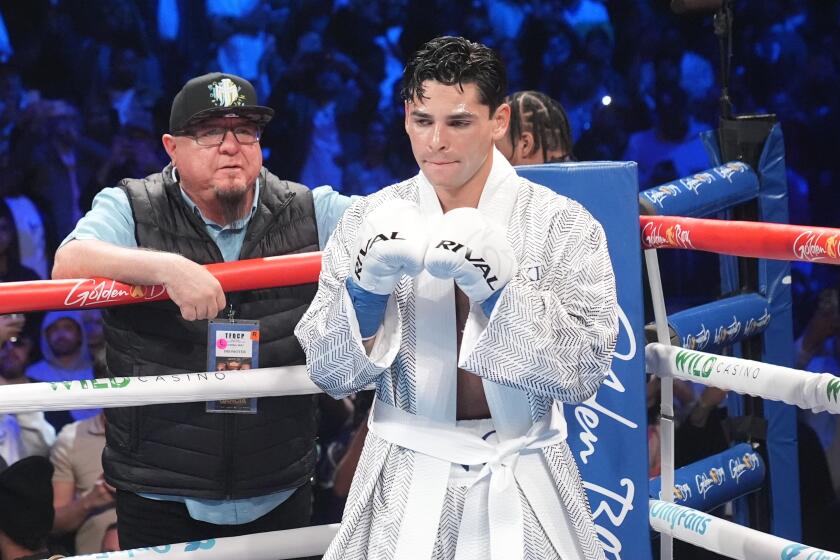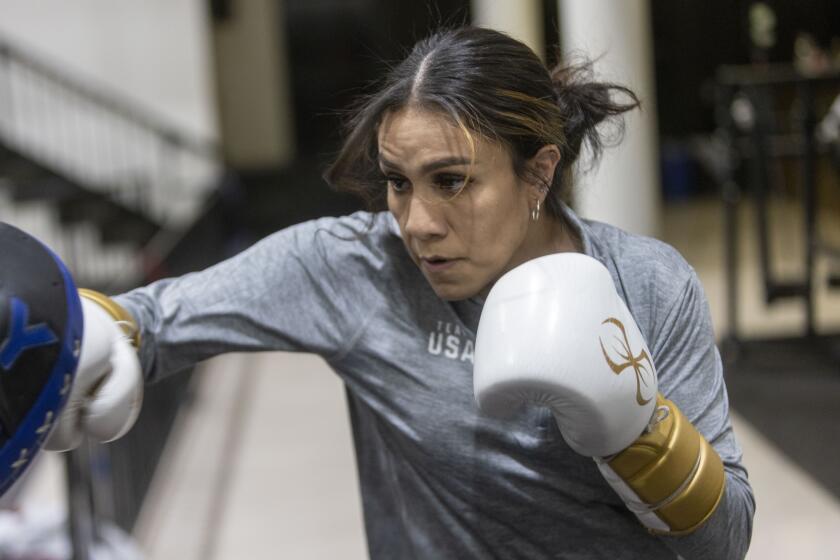Setups, False Names Focus of Boxing Probe
A federal investigation of one of boxing’s top promoters has uncovered evidence suggesting that thousands of professional bouts have been essentially rigged through fraudulent mismatches, authorities say.
There is no evidence so far that any championship fights have been fixed, and authorities are focusing their attention on only a fraction of the matches they suspect are tainted.
But law enforcement sources and others familiar with the nearly 2-year-old FBI investigation say authorities have obtained evidence that bouts featuring second-rate boxers using false names have become commonplace in at least eight states, including California and Nevada. The scheme almost always relies on the natural outcome of deliberate mismatches rather than on fighters taking dives, they said.
“Fixing fights is almost not worth it. It’s high risk,” said a law enforcement official who spoke on the condition of anonymity. “Why do that when 90% of the time, you can get the results you want by mismatching fighters?”
Pairing up mismatched fighters is not in itself illegal, but authorities say they are looking at a variety of federal and state laws that prohibit fraud, sports bribery, racketeering and other crimes. And though it may be difficult to prove that spectators were victimized, authorities say, there may be grounds for alleging that television broadcasters or other corporations were defrauded by sponsoring events that were more theater than sport.
Thus far, the investigation is focused on the Las Vegas-based Top Rank boxing organization. Its owner, Bob Arum, and rival Don King are the sport’s most powerful promoters. Agents served search warrants on Arum’s headquarters Jan. 6, confiscating more than 100 boxes of company records, including videotapes of Top Rank fights.
Although it remains unclear whether Arum or anyone else will be criminally charged, several people associated with Arum’s organization are known to be subjects of the investigation. They include matchmakers Sean Gibbons, Pete Susens and Bruce Trampler; manager Cameron Dunkin; as well as physicians, managers and others, such as boxing agent Robert Mittleman.
Top Rank spokesman Patrick Smith declined to comment on the investigation. Susens denied any wrongdoing; Trampler, Dunkin and Mittleman said they were aware that they were being investigated. An attorney for Gibbons said it would be inappropriate to discuss the specifics of the case unless charges were filed.
Although some details of the FBI investigation have filtered out since the search in Las Vegas, recent interviews offer the most detailed look so far at a probe that authorities say is months from completion. Among the disclosures:
* Over the last two years, federal authorities have reviewed scores of Top Rank fights and are focusing on as many as two dozen for prosecution.
But authorities say the practice of mismatching boxers has been so pervasive that thousands of fights around the country may have been compromised. The alleged motive was to inflate records that could lead to more lucrative matchups. The FBI “has talked to individual fighters who might have had 30 fights. And the fighters may say half of them were mismatched,” the law enforcement official said.
* FBI agents are investigating several bouts that led to the serious injury or death of boxers who arguably should not have been fighting. These include a fight in July in Utah featuring Brad Rone, 34, who collapsed and died in the first round while facing an opponent who had beaten him just a month earlier.
A winner of only seven of his 51 professional fights, the 5-foot-10, 260-pound Rone took the fight to earn $800 so he could help pay for the funeral of his mother. Instead, the two were buried on the same day in Cincinnati.
* An undercover New York City police officer posing as a mob-connected boxing enthusiast not only found evidence of corruption in the sport but ensnared several people by pretending to trade in stolen merchandise. In all, nearly $1 million in stolen cars, guns and drugs made their way to the front business run by the New York Police Department officer whose alias was Frank “Big Frankie” Manzione.
* Several doctors and referees may be implicated in the scandal, the doctors for falsifying medical records, the referees for failing to report deceptions designed to help some fighters build records.
* The alleged corruption among boxers, promoters and others includes falsifying Social Security records, immigration status and other forgeries, including fighters’ contracts.
Authorities said they had evidence that the boxing scandal stretches from Nevada and California to Arizona, New Mexico, Texas, Oklahoma, Utah and Michigan. The suspect fights, authorities said, involved a huge pool of young, desperate, unskilled boxers -- mostly from Mexico and elsewhere in Latin America -- who were put into the ring with opponents they had no hope of defeating.
Intentional mismatches are the most common fraud allegations, authorities said, with boxers using several identities to mask the fact that they are in fights that should not occur. In the process, winning records are manufactured for outclassed but willing boxers, who are then offered up as legitimate opponents for higher-caliber competitors.
The big payoff comes when fights are televised.
“The networks would not buy fights with these guys if they knew their real record,” said Jacob Hall, Indiana’s boxing commissioner. “But with the record the networks are shown, they pay the money.”
Boxing is vital to the economy of Las Vegas, where a title fight can translate into more than $100 million in hotel, restaurant and gaming revenue.
For some time, federal authorities in Las Vegas have pressed forward with an unrelated fight-fixing prosecution centering on allegations that boxer Thomas Williams and South Carolina matchmaker Robert Mitchell conspired to throw an August 2000 bout on the Las Vegas Strip. Both have pleaded not guilty.
But authorities said the FBI investigation of Top Rank more closely mirrors a six-month probe by the state of Oklahoma that found widespread examples of corruption.
A state report issued in 1997 on that investigation warned that boxing in Oklahoma and several other states could be rife with fixed fights, tax evasion, Social Security fraud and racketeering.
“The findings ... paint an unsavory picture of a sport barely one step removed from the carnival atmosphere of professional wrestling,” the report said, reciting stories of unscrupulous promoters, boxers using phony names and bouts between fighters “of little or no talent.”
No one was charged in connection with the state’s findings.
The current case, authorities said, did not spring from any federal or state probe. Instead, they said, it began almost two years ago when onetime teenage boxing prospect Joey Torres approached authorities in San Diego with a compelling tale of how professional fights were being fixed.
“He came to us [and] he convinced us,” the law enforcement official said. “He felt the boxing industry had treated him badly.”
Torres was trying to make a comeback after two decades in prison. Because he was scheduled to fight for Top Rank, the case was turned over to the FBI office in Las Vegas.
Two weeks before his first bout, Torres told agents that his opponent would take a dive, the official said.
Although Torres, then 41, won the fight, not everything went as planned.
“The problem was he had ballooned up in prison,” the official said. “He’s 5-[foot]-6 and weighed 200 pounds, so he had to fight as a heavyweight ... and he knew he couldn’t last more than a couple of rounds.”
Early in the first round, Torres was unexpectedly knocked to the canvas. Once Torres stood up, the official said, his opponent “literally carried him through the first round.”
Torres came back in the second round to knock out his opponent, winning the fight just as he had told authorities he would, the official said. But the outcome created a furor among fans that night at Arrowhead Pond of Anaheim.
The California Athletic Commission investigated and said it found no evidence of a fix. Torres is back in state custody at North Kern State Prison, for reasons unrelated to boxing, and could not be reached for comment.
His bout not only demonstrated an inside knowledge of the fight game but convinced authorities that he could help them uncover wrongdoing in the sport.
His biggest contribution was bringing the Las Vegas boxing scene a new and larger-than-life character: “Big Frankie” Manzione.
At 6 feet and 300 pounds, with the temperament of television mob boss Tony Soprano, Manzione arrived in town saying he had left an East Coast trucking business to establish himself in Las Vegas. He posed as someone who would fence stolen merchandise.
He was so believable as a boxing figure that one fight magazine recently named him No. 24 among the sport’s 50 most influential people last year. And he was so convincing as a con man, the law enforcement official said, that “people were literally showing up at his doorstep with stolen property.”
Over time, the official said, matchmaker Gibbons virtually attached himself to “Big Frankie” because of Manzione’s purported interest in making money off fights.
“Gibbons was with Frank almost every day,” the official said. “They were very close.”
With no charges filed, it would be inappropriate to discuss the FBI’s investigation, said Gibbons’ attorney, David Z. Chesnoff, of Las Vegas. But he acknowledged that Gibbons and the undercover FBI agent “knew each other.”
Mittleman’s Florida-based attorney, describing mismatches as common, said that the federal probe was focusing on how falsified records and other illegal methods were employed to ensure the outcome of fights.
“Mismatches are the very nature of the business,” said the attorney, Alvin Entin. “You have guys in there who can fight up against guys who are wearing toe tags.... It is just an accepted part of the business, though not for the better.”
He added: “Take a look at any of the really quality fighters today and you will see that they fought a bunch of fights early in their career with folks who had no chance of beating them. Because boxing has changed from the days of Rocky Graziano and Joe Louis and Tony Zale, when you could have 25 losses and still be a valuable commodity.”
Law enforcement sources say the investigation is still months from completion and downplay expectations that the case might lead to scores of indictments.
“The number of people is not significant,” said the law enforcement official familiar with the case.
“Whether it is five or 15, it doesn’t matter. What does matter is that it leads to changes ... in how boxing is regulated.”
One boxing insider agreed.
Even if mismatches are commonplace, this person said, the current FBI investigation is welcome if for no other reason than that the sport needs to be cleaned up.
“The industry needs a wake-up call,” the boxing insider said. “You don’t want people in the ring who shouldn’t be there. This is supposed to be a sport, not a blood sport. We don’t have gladiators anymore.”
Times staff writer Steve Springer contributed to this report.
More to Read
Go beyond the scoreboard
Get the latest on L.A.'s teams in the daily Sports Report newsletter.
You may occasionally receive promotional content from the Los Angeles Times.










